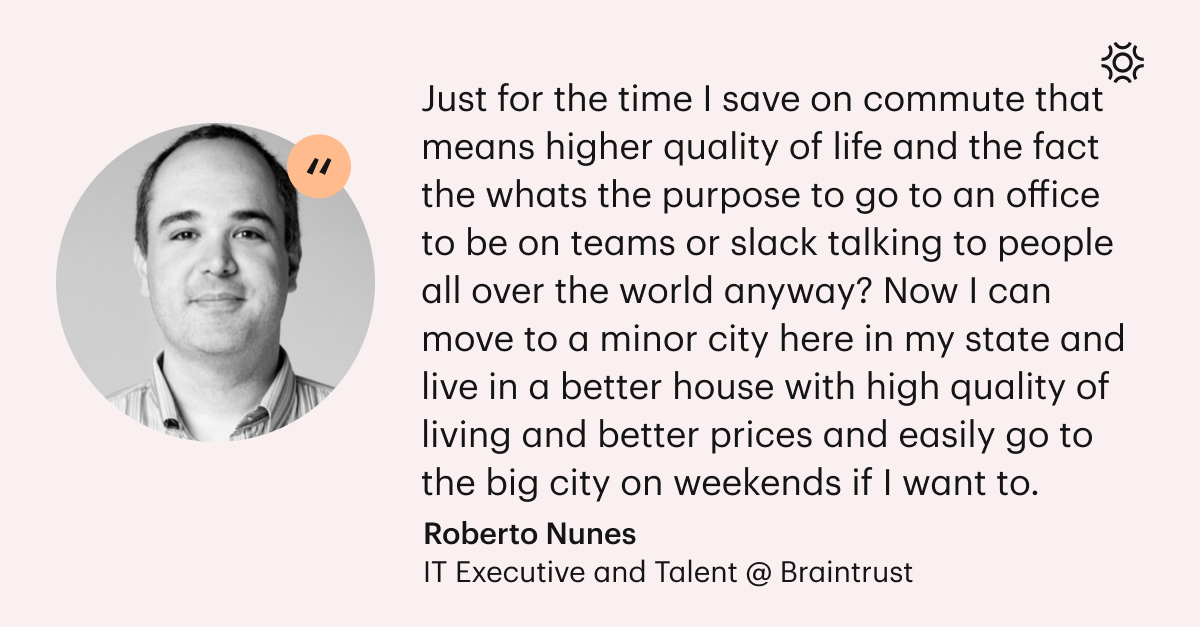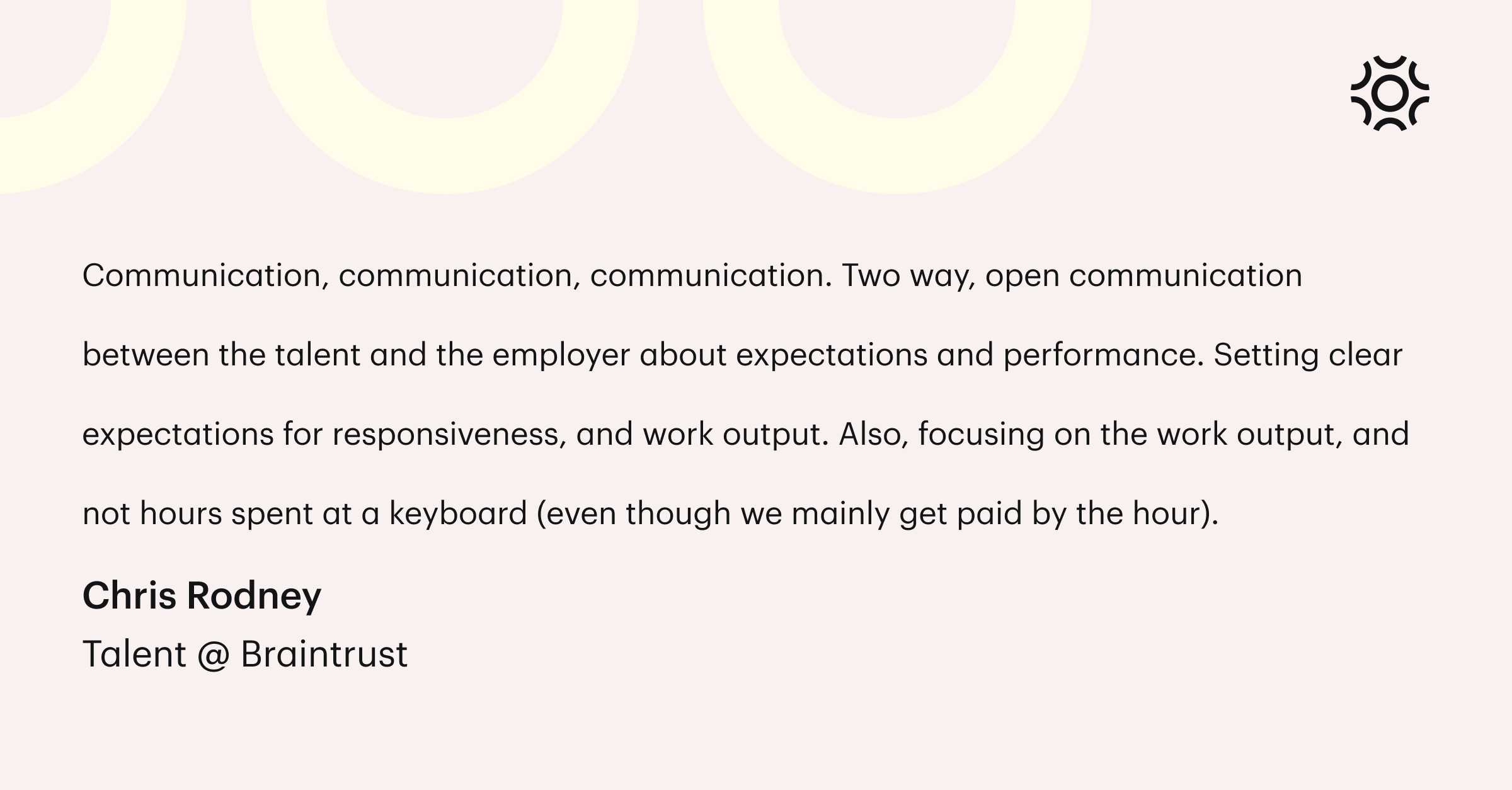The evolution of the workforce is upon us. As companies globally begin to find their stride after a year of remote work, one trend becomes evident: the rise of the hybrid work model. Yet, while the flexibility it promises is enticing, its successful implementation demands a bespoke strategy for every business.
The Hybrid Work Surge
The Changing Face of Workspaces
Gone are the days when 9-to-5 in-office was the only mode of operation. With giants like Nationwide setting the tone by broadening their work policies, it's clear that the hybrid work model—melding in-office and remote tasks—is here to stay.
What Employees Want: Flexibility Above All
A recent Harvard Business School survey affirmed what many suspected: a majority of professionals yearn for a mix of office and remote work. This desire stems from the lure of work-life balance, autonomy, the power to define one's work environment, and the opportunity to collaborate more organically with coworkers.
We asked the Braintrust community and got an overwhelming lean to remote with 66.6% of the votes. A third did choose hybrid, and no one choose in office.

Tailoring the Hybrid Model: No One-size-fits-all
A Custom Approach for Diverse Companies
What works for one company might falter for another. This truth underscores the hybrid model's inherent demand for customization. While some businesses empower teams to craft their schedules, others denote specific in-office days, ensuring optimal collaboration.
Take Bank of America, who recently hired 30+ designers, from Braintrust, as hybrid workers because they wanted to create an environment of collaboration. This balances what JP Morgan’s CEO said to CNBC,
“Remote work virtually eliminates spontaneous learning and creativity,”
with the benefits they saw during the start of Covid when they were fully remote.
Challenges of Managing Dual Environments
Balancing fully remote roles and the nuances of managing physical office space is challenging in the hybrid world. Moreover, businesses must remain vigilant to avoid potential pitfalls, such as discrepancies in opportunities between in-house and remote employees and proximity bias.
Embracing Full-time Remote: Unveiling Hidden Perks
The allure of fully remote roles cannot be downplayed. Beyond offering employees unparalleled flexibility, it signals a shift in company culture, emphasizing deliverables over mere presence. This change often fosters a spirit of trust and autonomy.
This evolution in work dynamics encourages self-motivation and accountability. As a result, companies witness heightened job satisfaction, increased morale, and more resilient workforce capabilities.
The Economic Ramifications of Remote Work
From cost-saving on office rentals to tapping into a global talent pool, the economic implications of remote work are vast. That includes Global Workplace Analytics' estimate of $11,000 in savings each year per remote employee for companies.
Companies now have the freedom to hire from anywhere, courtesy of external talent solutions and global staffing agencies, ensuring they have the best value talent. Atlassian CEO, Scott Farquhar, says it best:
“The overall decision [to go fully remote] was easy enough; the hard part was working out the details.”
Not only good for companies, the time and cost of living savings are huge for employees. Talent is able to select a better cost of living area and afford a more value place to live, while fulfilling on their work obligations, instead of spending the time commuting.

Navigating potential Inequalities in Hybrid Spaces
A hybrid model, though promising, is not devoid of challenges. Potential inequalities—whether in terms of visibility, opportunities, or promotions—between remote and in-house staff do emerge. Addressing these discrepancies is vital to ensure fairness, maintain morale and grow a thriving company culture.
You can help by ensuring equitable access to professional development opportunities, and curbing the unintentional sidelining of remote participants in meetings by giving everyone space to express themselves, and paying attention to distance biases
Trust: The Pillar of Hybrid Success
Trust in a hybrid environment goes beyond ensuring tasks are completed. It's about leaders believing in their team's commitment and employees feeling valued and trusted to manage their responsibilities, irrespective of their work location.
Technology: Bridging the Physical and Virtual Divide
In the realm of hybrid work, technology plays a pivotal role. From cloud computing solutions that ensure seamless data accessibility to software engineering tools that enable collaboration, tech is the glue binding the dual worlds.
The Heart of Hybrid: A People-Centric Approach
Above all, the essence of the hybrid model lies in its focus on people. Businesses prioritizing employee well-being, fostering open communication, and valuing each individual's unique contributions will inevitably thrive in this new era.
Rebecca Popoola an ajile scrum master with over 10 years of experience, explains
Fostering Unity in a Hybrid World: Tips for Seamless Collaboration
Begin with transparent scheduling, ensuring all stakeholders—be they in-house or remote—are aware of, and can contribute to, team touchpoints. We already spoke about the need for collaborative platforms, like Slack or Microsoft Teams, to emulate the spontaneity of an office chat, but more personal touch points such as monthly 'virtual coffee breaks' can serve as relaxed forums for brainstorming while regular feedback loops guarantee remote workers feel heard and an equal part of the same team. Remember, the goal isn't just consistent communication and meaningful connection that fosters a unified team spirit, irrespective of physical locales.
Tips for Hiring Employees that will Thrive
In today's evolving job market, hiring in a hybrid environment presents unique challenges and opportunities. To ensure success:
- Start by clearly defining the roles, emphasizing the flexibility and expectations associated with both in-office and remote work.
- Leverage technology, such as video interviewing tools and collaboration platforms, to assess candidates' adaptability to virtual communications.
- Consider introducing a "remote work readiness" evaluation as part of the interview process to gauge candidates' self-discipline, time management skills, and proficiency with digital tools.
- It's equally important to prioritize cultural fit; ensure that potential hires align with your company's values and can thrive in a blended work setting.
- Remain transparent throughout the recruitment process, providing clarity on remote work policies, team dynamics, and growth opportunities within the hybrid framework.
This comprehensive approach will ensure you attract talent best suited for the opportunity and complexities of a hybrid work environment.
Charting the Course for a Hybrid Future
The hybrid work model presents a wealth of opportunities, but it also requires careful navigation with insight, understanding, and foresight. As companies around the world navigate this landscape, one thing is clear: success is not determined by location but by our ability to collaborate effectively.
Interested in hiring hybrid or fully remote employees? Our network has top talent interested in both work environments. Start your hiring today by signing up!






